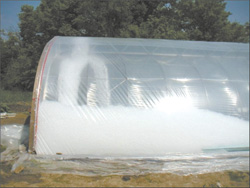
A little soap and water solved two of the biggest challenges facing greenhouse owner Russ Elliott -- keeping his greenhouse warm in the winter and cool in the summer.
Elliott's ingenious solution involved covering an aluminum framework with a double layer of plastic and then filling the gap between with soap bubbles using a foam generator and irrigation pump. When his southern Ontario weather gets too cold in the winter or too hot in the summer, he simply turns on his bubble machine. At the same time, rainwater reservoirs act as heat traps to help warm the greenhouse in the winter and cool it in the summer.
"Growing food in northern winter greenhouses is often not economical due to the high cost of heating," says Elliott.
The key was to use two layers of plastic and generate a layer of liquid foam to insulate the greenhouse. The same layer helps shade the interior from too much heat in the summer.
Today, Elliott's wife Kathryn harvests herbs and vegetables on even the coldest winter days with only a little help from a wood stove. A heat recovery system brings in fresh air and exhausts excess humidity.
When Elliott built his prototype greenhouse, he added two 2,500-gal. tanks below ground level, running the length of each side of the greenhouse. Filled by rainwater runoff from the greenhouse roof, the reservoirs provide water for gravity fed irrigation lines in the raised beds and thermal mass storage. Insulated sides hold in heat, while the uninsulated bottom of the reservoirs capture ground heat.
Elliott mounted his foam generators in the ridgeline of the greenhouse with one facing the north side and one the south. An irrigation pump supplies the solution to the foam generators. Filling the north side in the winter during the day allows sunlight to penetrate from the south side while reducing heat loss to the north. At night, both sides are filled with bubbles to reduce heat loss. During the summer the south side can be filled to reflect excess sun and lower interior temperatures.
The bubble solution used for foam generation drains back into an underground tank for warming and reuse. Supplemental warming in the winter is provided by a system of evacuated tube solar collectors.
Filling the entire roof cavity with foam takes less than 3 to 4 minutes, reports Elliott. A simple timer activates the system every hour throughout the night to replenish dissipated bubbles.
"Payback would depend on the climate and the crop grown," he says. "Here in Ontario, with a low temperature set point of 40 degrees F, payback would be about 10 years."
